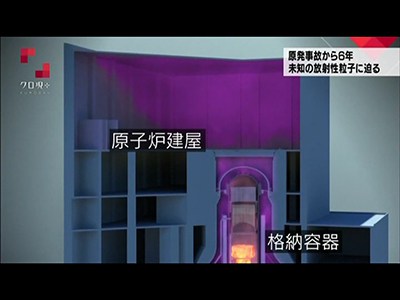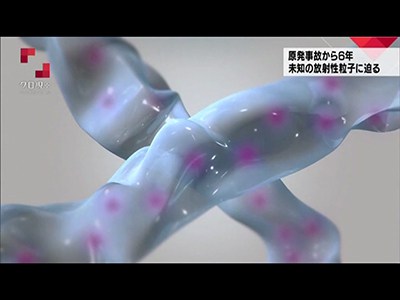
We are presenting here a transcription of an NHK TV documentary (note1) on insoluble radioactive particles found in Fukushima and in the Tokyo metropolitan region. This is the 2nd part of the 3 parts.
Here is the first part.



Insoluble radioactive particles that do not dissolve in water.
This characteristic is supposed to make a big difference when considering health effects.
In the past, radioactive cesium emitted in the nuclear accident was thought to be carried away adhering to water-soluble particles called aerosols in the atmosphere. When it touches the water the particle melts and the cesium diffuses and gets diluted. The same is true when it is inhaled in the lungs; the water-soluble cesium melts into the body fluid and spreads thinly throughout the body. Then it is supposed to be discharged gradually by the metabolic activity, and decreases by half from 80 to 100 days in the case of adults.

Insoluble radioactive particles, on the other hand, do not dissolve in body fluids. For example, if they adhere to the alveoli at the furthest areas of the lungs, it may take years to discharge. Even with the same amount of cesium, the dose of lung exposure is about 70 times higher than in the case of water-soluble cesium in the case of adults. As for the infants who are more radiosensitive, the dose of exposure is supposed to be approximately 180 times higher.



In fact, this insoluble radioactive particle has not been identified in past nuclear accidents. Why was it emitted in the accident of the Fukushima nuclear power plant?
Yukihiko Sato, who is doing research on this particle, is focusing on the insulation material that contains glass components. It is used in parts such as piping in the nuclear power plant.
A special electron microscope is used to analyze the proportion of elements contained in the radioactive particles and in the insulation material.
The top is radioactive particles, and the bottom is the insulation material.
The proportion of elements, such as silicon and oxygen, which are the main components of glass, is well matched.





From this, Mr. Sato thought about the scenario where the radioactive particle formed as follows:
Radioactive cesium was emitted from the melted nuclear fuel in the event of the accident. It first filled the reactor. Then, it leaked into the reactor containment building.
Cesium was absorbed in the insulation material in the building.
After that, a nuclear reactor building blew up by hydrogen explosion.
As the insulation material melts and becomes glass, cesium is taken in. And with the explosion, it became small particles as it dispersed in the blast.




The radioactive particles found by Sato are in diameter from 0.5 to 500 micrometer. Their shapes vary from a smooth round one to a rugged one.

Tatsuhiko Sato of the Japan Atomic Energy Agency.
He simulated the health effects of insoluble radioactive particles using a program to calculate the behavior of each ray. For the simulation, he used a particle of the size which enters the lung, and which is actually found. He compared the simulation of the insoluble radioactive particles remaining to adhere to the same spot on the surface of the organ, and that of the same amount of radioactive material adhered uniformly on the surface.



In the case of uniform adhesion, even after 24 hours, blue and light blue areas are spread out indicating that the radiation dose is low.





On the other hand, in the case of the particle, the dose near the spot increases locally and orange and red areas are expanding.

Even with the same quantity of radioactive materials, the health effect may change.


In fact, there are data of people who may have inhaled insoluble radioactive particles. This is a survey of TEPCO employees who had a large amount of exposure during the nuclear accident.



The amount of the radioactive materials in the body is examined regularly, and the graph in red shows that the value of the vicinity of the chest is comparatively high. While the radioactive cesium that had spread throughout the body decreased over time, only around the chest the speed to decrease was slow. The inhaled insoluble radioactive particles are suspected to remain in the lungs.


However, researchers say that the amount is not significant enough to worry about the health effects, according to the International Commission on Radiological Protection.
Takeda: Mr. Michiaki Kai is a specialist in the radio-induced health damages and radioprotection.
If the insoluble radioactive particles stay in the body, the radiation dose may increase locally. And according to some experts, it is necessary to investigate the health effects. What is your opinion?
Kai: First of all, you know that the dose is a measure of health effects. However, when we compare the dose, you cannot compare the cases of smaller and larger exposures ranges. In general, the greater the exposures range, the greater the health impact is. In that sense, the larger the average dose of an organ or an entire system is, the greater the impact is. Therefore, it is important to evaluate the average organ dose even in the case of the insoluble particle. However, there is a possibility that the dose becomes high very locally, so it is important to evaluate it properly, since some people worry about it. This is why such an evaluation is carried out.
Takeda: The overall exposure more than local exposure is …
Kai: If it is the same dose, the impact on health is larger if the range of exposure is wider.
Takeda: You mean that the impact is larger, but it is also necessary to examine a local exposure.
Kai: I think that it is necessary to examine it properly.
(To be continued in the Part 3)
_____
Note 1: Close-up Gendai, Genpatsu jiko kara 6 nen, Michi no hoshasei ryushi ni semaru (Approaching radioactive particles six years from the nuclear accident) (diffusion: 2017 June 6)
https://fukushima311voices.wordpress.com/2017/07/14/insoluble-radioactive-particles-part-2/

Reblogged this on 20 millisieverts per year.
LikeLike